|
|
|

16 December 07: BRRRR
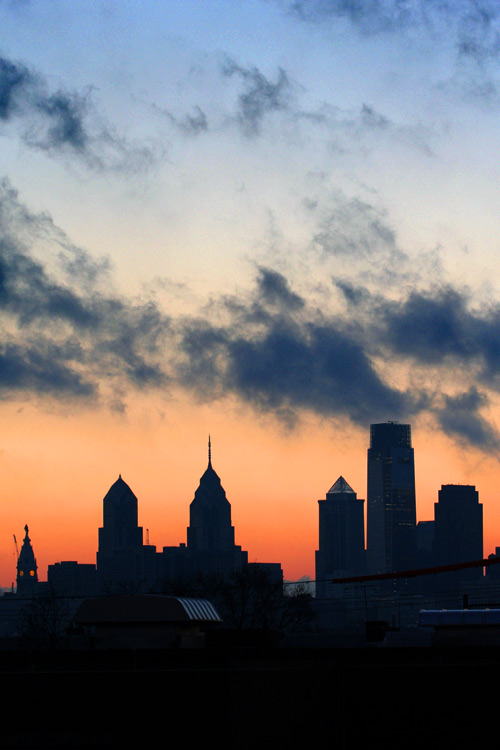
Eagles win in Dallas, Alycia Lane's arrested for punching a New York City cop, the President's House site has a newer, better design, and the Jersey Shore is
covered in sea foam . . . but the big story this weekend: baby it's COLD outside!
Click that frigid photo there for the latest round of Comcast updates from the weekend.
But most importantly: THANK YOU ALL who took time out of your office holiday parties to spend a little time with the calendar crew on Friday night. Good
times were had by all, and the good times were rounded out . . . with a lamb sandwich (right after the foie gras protesters left).
If you were unable to make it and you'd still like to purchase a calendar, why, stop on by Conspiracy, or what the hey, just click RIGHT HERE to buy it online.
THANKS EVERYBODEEEEEEEE!
–B Love
|
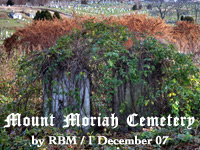 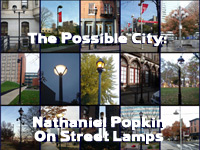 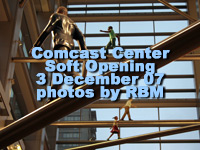 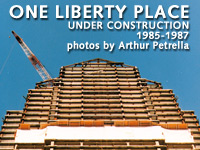
14 December 07: Tonight's the night
It's gonna be all right
Well HOT ROD, this is it! There's a Philly Skyline party tonight, and you my friend, you are invited. There are calendars, there are framed photo prints, and there
is free booze (IF YOU ARE TWENTY-ONE, THAT IS). It's right in the heart of Northern Liberties, so why not make a night of it, stop in Conspiracy for the ten minutes
it takes to drink a 12 oz High Life and then go hit the bars. (Have I mentioned the lamb sandwich at Standard Tap? I have? Well I meant it: IT'S AWESOME.)
Tonight's the night: 6ish to 9ish, calendars, prints, beers, me & you. Let's do this.
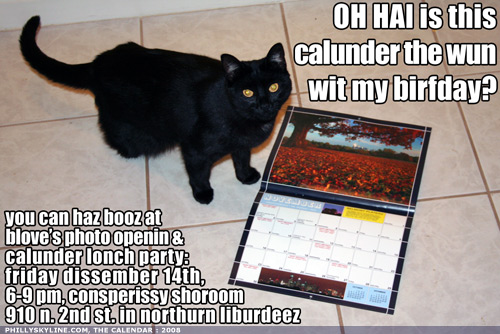
–B Love
|
14 December 07: False alarm: no tram yet (thank god)
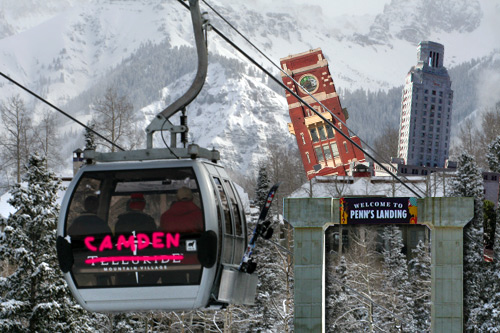
Chances are you caught the news yesterday that the Delaware River Port Authority's 2008 budget passed. Check Paul Nussbaum's Inquirer story and Eileen
Stillwell's Courier-Post story if
not. (Or, if you prefer, the December 7 editorial by Gerald McOscar which, for some only-in-the-Inquirer reason, includes a sketch of the Golden Gate Bridge . . . the iconic bridge
connecting San Francisco and Marin County, California.)
DRPA, the bistate agency which operates all four vehicular bridges from the Commodore Barry to the Betsy Ross, PATCO, the Cruise Terminal and the RiverLink Ferry,
has discussed the possibility of raising tolls on the bridges and fares on PATCO. The budget that just passed does not account for toll hikes, but that option is
not off the table and public hearings on just that begin in January. So, you can still expect a hike (the figure I've seen tossed about most frequently, but which by
no means is anything more than a rumor, is a dollar, so the new toll would be $4), but exactly when depends on the DRPA hearings. My money's on July 1st.
The 2008 budget sees increases in operating costs and infrastructure improvements, and all things considered, that's acceptable. PATCO's trains are nearly 40 years
old and, as we learned harshly in July, bridges are manmade structures whose upkeep needs to be taken seriously. So it was with curiosity that I noticed the $57
million allocation for the Delaware River aerial tram.
Readers of this site know how I feel about a big, stupid, ugly, nonsensical amusement park ride left over from an era where a giant shopping mall was the idea of a
good time and good planning at Penn's Landing. Fortunately, that never panned out, but UNfortunately, nothing else has either. Fortunately again, that also meant
that the big, stupid, ugly, nonsensical amusement park ride was never built.
In the 2003 Penn's Landing forums, the four proposals all included the tram -- because they were required
to. Two of them seemed to embrace the tram: Daniel Keating, whose Hyatt hotel at Penn's Landing would obviously benefit from it, and Atlantis, whose entire concept
resembled a neon Las Vegas abortion ("steaming grottoes" was the catch phrase I latched onto). The other two effectively paid the tram lip service because they had
to. Cesar Pelli and Brandywine Realty's plan featured a minimalistic tower support, and Bart Blatstein's looked like it was drawn on in pencil: "oh you were
serious about the tram? Sure, one sec . . . [draws tram tower] . . . ok, here you go." Bart even joked about the tram when asked about it ("yes, it's
everyone's dream to ride an aerial tram to Camden"), drawing laughs from everyone in the audience. Four years, an FBI investigation and however many indictments and
sentences later, we know what came out of those forums.
Anyway, the '08 budget. You can look over the actual documents on DRPA's web site HERE. Neither the 2008 general budget nor 2008 operating budget makes mention of the tram by name, and you have to go to the five year capital
budget just to find it. In 2008, only $25,000 is allotted for it (for a feasibility study?), with increases in the following years. That money, however, is
predicated on the notion that something will be built at Penn's Landing.
DRPA specialist Danelle Hunter says, "the tram is a dream of ours, but we can't build it until there's something at Penn's Landing for it to go to."
At Penn Praxis' presentation for their Civic Vision for the Riverfront two weeks ago, Harris Steinberg was asked specifically about the tram, and he said bluntly,
"there is no tram in this plan."
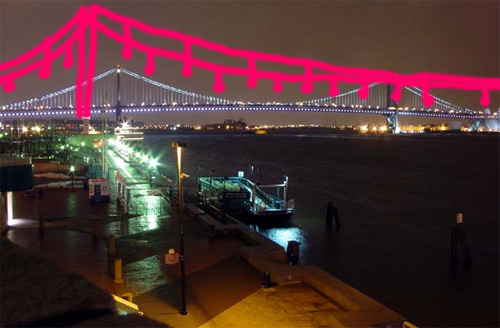
Artistic and highly scientific interpretation by B Love, done in approximately 32 seconds.
The tram is completely unnecessary. The RiverLink Ferry already takes people from Penn's Landing to the Camden Riverfront, and the Camden terminal is right smack in
the middle of the attractions there: Campbell's Field, Adventure Aquarium, FERRY TERMINAL, Wiggins Park, Marina, Tweeter Center, Battleship New Jersey. On our side,
the ferry terminal is right at the Seaport Museum, adjacent to the Hyatt, Olympia, Becuna, and Moshulu, and the footbridges into Old City and the Independence
historical area.
Perhaps some of the five-year $57M could go instead to better service to the ferry -- the last
departure from Camden is 4:30pm! Most people aren't even out of work by then. Let's say you live in Old City and work in Camden, for Lockheed or for one
of the attractions or for Camden City/County or for Rutgers or for DRPA itself . . . that leaves you with one option: to drive.
Ferry rides are pleasant, and for colder
months, heated. Trams always, always stop at some point. We've all been on a ski-lift or the Hersheypark Skyview and had it stop, causing the tram car to
swing and everyone inside to nervously laugh. (Remember that stupid Royal Bank of Scotland commercial where it did the same thing and the dude goes on about the
power of positive thinking and the girl frantically combs her hair and the smart Royal Bank of Scotland guy presses the green button?) Well imagine all the fun
nervous laughs a swinging tram car stuck a couple hundred feet above the mile-wide Delaware River would bring!
And what would the tram look like? It would look like a Ben Franklin Bridge knockoff trinket is what. (See above diagram.) One of the few redeeming qualities of the
current version of Penn's Landing is its view of the Ben Franklin Bridge. A tram would completely obscure it, especially from the Great Plaza, one of Penn's
Landing's other present assets.
Let's not forget PATCO's Franklin Square Station, either.
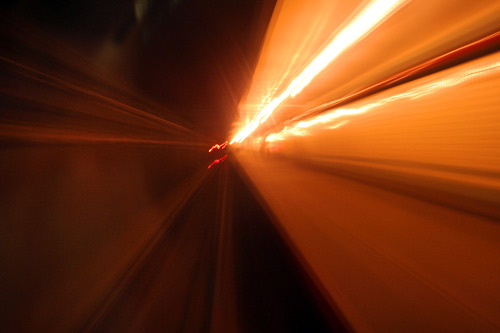
The Inquirer's Paul Nussbaum also wrote about Franklin Square Station in an excellent July article.
Franklin Square Station has had at best a teetering existence, opening and closing several times due to low usage, most recently in 1979 after a Bicentennial run.
But, considering Center City was vastly different in the 70s, and several new contributors to critical mass have arrived (the Constitution Center, a renovated
Franklin Square park, Metroclub, and to a lesser extent, Old City bars and clubs . . . remember, PATCO runs from Jersey), maybe it's time to reconsider. From that
article:
[PATCO President John J.] Matheussen estimated it would take $5 million to $10 million and a couple of years to reopen the station. He said new entrances
would be needed, as well as upgrades to accommodate handicapped customers and new fare technology.
Fair enough. Let's highball that estimate at $10 million. That's less than one-fifth of the cost set aside for the tram, is far more practical, and would require far
less (and far less disruptive) construction. If it proves to be a failure and still no one uses the Station, it at least doesn't leave us with a mile wide eyesore.
Please DRPA, let it go. Cut your losses now, kill the tram, and move that money into better projects: better ferry service and the use of a train station that
already exists.
–B Love
|
   
13 December 07: Philly Skyline bites!
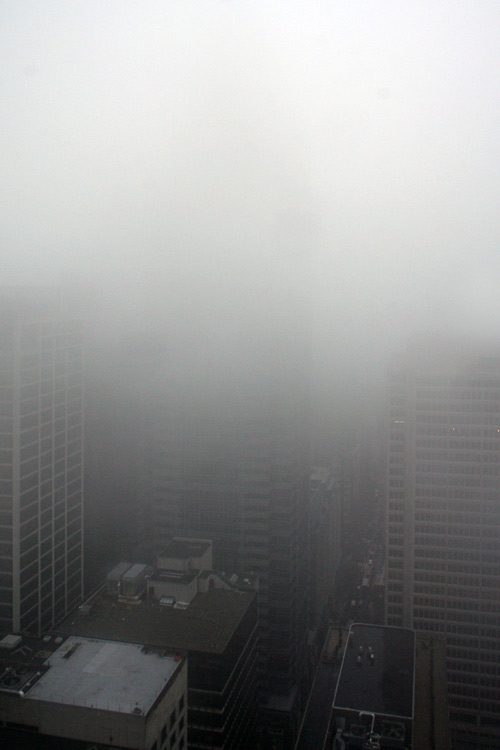
It was a day like this, cold and rainy and gray, exactly one year ago, when yr Philly Skyline first got the Comcast Center hard hat treatment. The photo above is the
"view" of One Liberty Place from the 33rd floor, then the highest possible without a cable harness.
Knowing what we know and seeing what we see now, it's interesting to do the before and after (especially within the
winter garden, including the grand staircase). The hard hat tour from a year ago is HERE, and the
usual Comcast Center updates (which will most likely continue up till the official opening in May) are HERE.
In the 365 days that have passed since then, the Philly Skyline has changed significantly thanks to the growth of that same building, plus the Murano, Symphony
House, and some shorter buildings around town like the Western Union, 101 Walnut and American Loft. 10 Rittenhouse Square is next, W's not far behind,
casinos* appear to be in line, and there's an awful lot of noise being made in the Barnes Tower Parkway 22 and Trump Tower camps. And then we
consider the possibles like 18th & Arch and 19th & Walnut (not to mention hopefuls like Mandeville Place and Bridgeman's View Tower), and we're still growing and
growing more.
* Casinos will be the subject of a forthcoming post, since they seem somewhat imminent and since Philly Skyline has long taken the decidedly non-stance
stance.
So, with the physical skyline, it's always fun to see who's taking notice. Here's a recent look around town . . .
PHILLY.COM: Might as well start with the one we've already discussed and which at least a dozen people have emailed about in the
past couple days (thanks for that). Seems the good folks put to work designing the web site of the region's largest news source took our advice and snapped
themselves a new picture.
Old:

New:

So, thanks for listening over there. It's not perfect, but it's good.
[Philly.com.]
* * *
SPRINT . . . PLEASE JUST STOP.
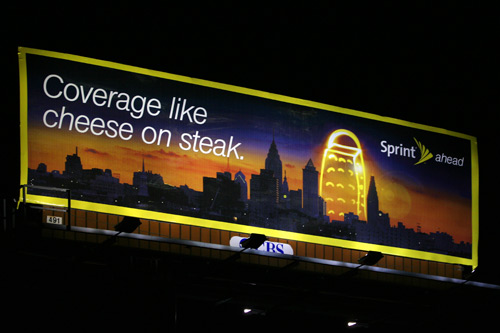
As if Sprint's stop motion ad campaign is not already annoying enough, these billboards have popped up all over the region's billboard corridors (which is to say
everywhere, but mostly in the city and poorer cities like Chester).
In this particular image, Two Liberty Place is shrunken to make room for the ad's text, and as there was a gap where Comcast Center is now (which already dates the
stock image used), it is replaced with . . . a cheese grater? Is that what that thing is? I thought it was a remote control when I first saw it, but everyone
I know says it's a cheese grater. Which, again, shows exactly what Sprint knows about Philly: ain't nobody GRATING cheese for a cheesesteak. Cheesesteak cheese is
either sliced or put on in dollops, scooped out by spoons or by paint stirrers. This Fishtown billboard alone confirms that I will never use Sprint's services.
* * *
AT&T . . . EH, IT'S BETTER THAN SPRINT ANYWAY.
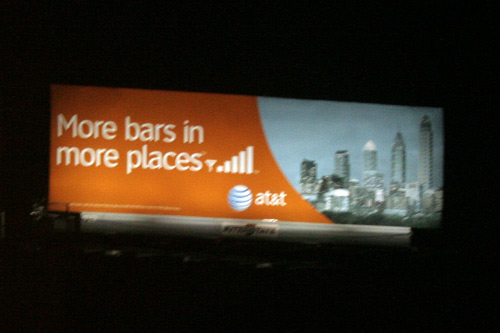
The "more bars" campaign's not bad -- there are at least some clever "more bars" composites. This academically virtuosic photograph, taken at about 1/40th shutter
speed from a car moving at highway speed, was taken on the north side of the Girard Point Bridge. Two Liberty Place is photoshopped in this one too, the classic
South Street Bridge view, but made bigger for the "more bars" jawn. Not bad, AT&T.
* * *
FOX29:

Props are definitely in order for Fox29/My Fox Philly/Casa de Jen Fred. The local Fox affiliate has been up on the new skyline since before it was the new skyline.
Their news vans have been decorated with a Comcast Center river rendering souped up with Stormtracker graphics for a good two years now, and to my knowledge, Fox's
Michelle Williams is still the only local network newsperson to have actually toured the building for a news segment.
The graphic above could use an update, as the scaffolding around City Hall's Swede and Indian sculptures has been removed, and Comcast Center's actually there
now (and a little to the left), but it's a nice graphic all the same. Kudos, Fox29.
[My Fox Philly.]
* * *
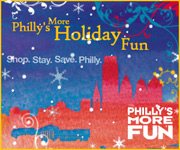 PHILLY'S MORE FUN:
Ahh, now thatza nice-a graphic.
PHILLY'S MORE FUN:
Ahh, now thatza nice-a graphic.
GPTMC and the gophila.com crowd should be on top of this sort of thing since they're promoting the latest and greatest in the
city. It's colorful, festive and interpretive, i.e. it's not verbatim but they've taken it and molded it for their purposes, and in this case it's aesthetically
pleasing. GPTMC, my compliments to the graphic design team.
[GoPhila.com.]
* * *
IMAGINE PHILADELPHIA:

Been meaning to write about this for a couple weeks now. The City Planning Commission is building on the public dialogue of planning, taking a cue from incoming
mayor Michael Nutter's endorsement of a new comprehensive plan for the city, and engaging the public to do just that.
With next to no notice, the Planning Commission announced that meetings would be held in South Philly, Olney, Northeast Philly (those three have passed) and West
Philly (that one is tonight). Four more -- in North Philly, Northwest Philly, the Riverfront and Center City -- will be held in January. Mind you, these are not your
average civic association meeting -- this is the actual Planning
Commission.
The intent is to create the first master plan for the city in over 40 years, from neighborhoods to the skyline to parks to the business district (if I might borrow
from their concept). Ed Bacon made it not only happen, he made it fashionable and famous. So too can his successors -- but they would like your help. It's
our city, so let's put on our thinking caps and do this thing.
Anyways, the skyline graphic. Also interpretive, and inclusionary of Comcast Center . . . but it's a little blocky, a little heavy on the Illustrator polygons,
maybe. The little homes in front of the skyline beyond is reminiscent of San Francisco's Alamo Square (their South Street Bridge postcard shot), but being Philly,
rowhomes would have been nicer (and could have been illustrated by cornices and windows) than separate standalone homes, but over all, the graphic isn't bad.
[Imagine Philadelphia.]
* * *
Well now I do hope you've remembered your galoshes, b'gosh, so stay dry out there today and get yo funky self ready for all tomorrow's parties, but mainly ours.
Philly Skyline, The Calendar: 2008 is printed, in boxes right here at the Fishtown PSHQ, and awaiting placement on shelves, walls, and your heart. The party's
tomorrow from 6ish to 9ish at Conspiracy, 910 N 2nd St in Northern Liberties. Come for the calendar,
stay for the booze.
–B Love
|
   
12 December 07:
FYI: Billy Penn is free at last
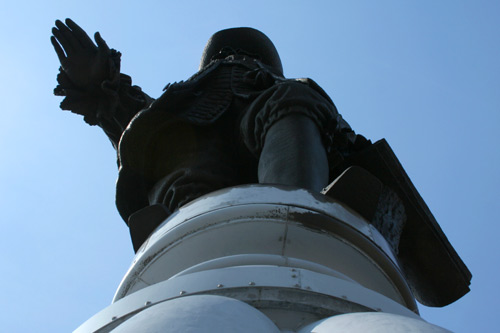
But visiting him is not. It used to be, but nowadays it costs you five bucks. If you're willing to drop a five spot for the view from the center, you are once again
able to do so.
After over two months of closure to support the scaffolding for the Billy Penn wax job, City Hall's
observation deck is officially open again. As always, the hours are 9:30am to 4pm Monday through Friday, and the $5 tickets can be purchased in Room 121 in the east
portal on the ground floor.
–B Love
|
   
12 December 07: SHHHHHHHHHHH
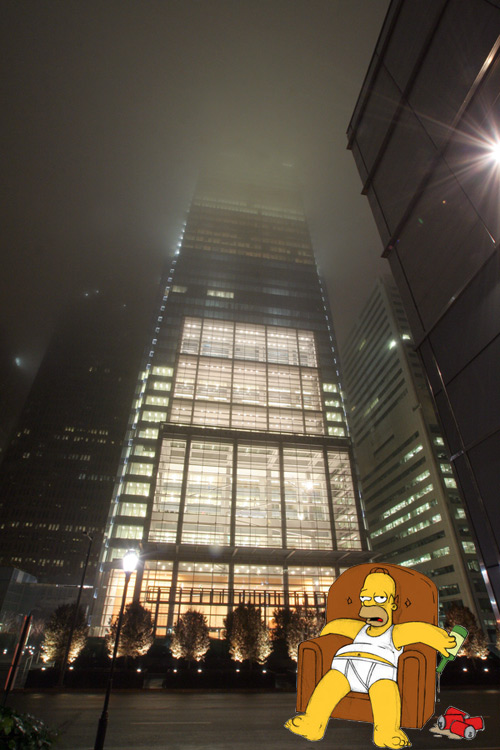
Not so loud, please. Head foggy like last night foggy.
–Blaaaaaaaarve
PS: Philly.com updated its banner graphic to a newer picture that includes Cira Centre, Murano and Comcast Center. Nice work. UPDATE: looks like there's one image
for the evening and one for the daytime. Well played, philly.com.
|
11 December 07:
*** PHILLY SKYLINE PARTY MEMORANDUM ***
Consider this the official announcement: Philly Skyline is throwing a party -- and you're invited!
Philly Skyline, The Calendar: 2008 becomes available for consumption at six o'clock sharp on Friday evening, so come out and celebrate with us, why don'tcha?
The lovely ladies of Conspiracy Showroom have again graciously offered up their space for
calendars, big photos and free booze. (Never mind the rest, you're coming for the free booze.)
Information on the calendars is found by clicking the graphic above, but all you really need to know is 1, it's a calendar, 2, it features all
original photos (by the B Love fellow) from all over the city, 3, it's 20 bucks. Twenty bucks! You can't even buy a concert ticket for twenty bucks any
more, and that's for something that lasts two hours and hurts your feet. Philly Skyline, The Calendar: 2008 lasts all year and beyond, it organizes your life
chronologically, and it's got a bunch of 8x10s you can frame when the month is done.
And, you can buy them in person at Friday's party from 6ish to 9ish, or whenever the booze is gone and everyone leaves because the booze is gone. Conspiracy will
carry the calendars throughout the holidays, but Friday's the only day with free booze.
Same as last year, the party is also the opening of the month-long show of B Love's Big Ass Photos ™. There are four 11" x 14" and four 20" x 30", all
framed and printed on colorful matte paper. Your mom would love one. And when she hears it's from B Love, she'll really want it, if you know what I'm saying.
If you don't, just ask her.
But yeah, party! Friday night! Conspiracy's at 910 N. 2nd Street (just above Poplar), so take the El to Spring Garden and spend eight minutes walking there. Or
longer if you stop in 700 Club or Liberties or the Foodery or Standard Tap or North Bowl. All of those watering holes will satisfy your inner lush when our free
booze is gone. So come by, won'tcha?

–the B Love fellow
|
11 December 07: The real estate of death:
How many people will Mount Moriah carry in the end?
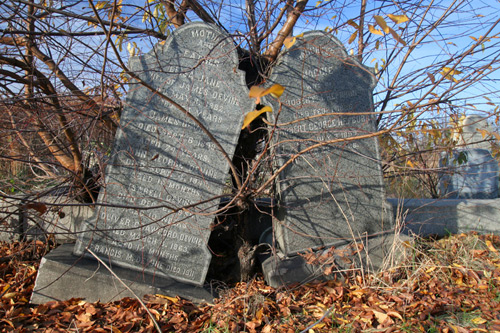
Aw, God said to Abraham "kill me a son." Abe said "man, you must be puttin' me on." God said "no." Abe said "what." God said "you can do what you want Abe, but, the
next time you see me comin' you better run." Well Abe said "where do you want this killin' done?" God said "up on Mount Moriah in Jerusalem" -- later and more
famously known as the Temple Mount.
Abraham's binding of his son Isaac (in preparation of sacrificing him -- out of his fear of God -- which was diverted by an angel) is sacred to and interpreted
differently by each of the three major religions. In the tenth century BC, King David envisioned the site as the spiritual center of his burgeoning kingdom of Israel
and he instructed his son Solomon to build a temple to serve it. Three thousand years -- and several raids, destructions, reconstructions and more destructions --
later, the site of Solomon's temple is still a pillar to Jews, Christians and Muslims.
Though many geographic names hold a religious derivation (Bethlehem and Nazareth, PA, for example), Mount Moriah doesn't seem to be a common one. Two mountains in
the US (in New Hampshire and Nevada) and a Missouri village of 143 people share the name Mount Moriah. And, in Southwest Philadelphia up on a hill above Cobbs Creek,
Mount Moriah Cemetery is the final resting place of thousands of people.
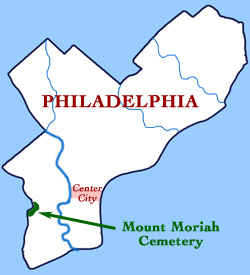 Mount Moriah Cemetery was incorporated in 1855, one year after the Act of Consolidation folded all boroughs (like Chestnut Hill and Frankford) and townships (like
Northern Liberties and several in the Northeast) under the auspices of a coterminous city-county government. Previously Kingsessing Township, Southwest Philly was
now technically part of the city, but it was still very much a rural, hilly area -- the type of area that was in 19th century vogue for burial grounds, like Laurel
Hill (1836) and Woodlands (1840) before it. However, it wasn't just fashion that begot rural cemeteries; there was the legitimate concern on the handling of dead
bodies in compact, urban places, particularly cities where small, church cemeteries were approaching their finite capacity.
Mount Moriah Cemetery was incorporated in 1855, one year after the Act of Consolidation folded all boroughs (like Chestnut Hill and Frankford) and townships (like
Northern Liberties and several in the Northeast) under the auspices of a coterminous city-county government. Previously Kingsessing Township, Southwest Philly was
now technically part of the city, but it was still very much a rural, hilly area -- the type of area that was in 19th century vogue for burial grounds, like Laurel
Hill (1836) and Woodlands (1840) before it. However, it wasn't just fashion that begot rural cemeteries; there was the legitimate concern on the handling of dead
bodies in compact, urban places, particularly cities where small, church cemeteries were approaching their finite capacity.
As the city grew outward and Southwest Philly developed, the trolley ran along Kingsessing Avenue (which still borders Mount Moriah Cemetery), allowing people
from all over to visit deceased loved ones, or even picnic in the idyllic setting on the hill above Cobbs Creek. This concept may seem unusual or even creepy to us
now, but (as this web site mentioned in the Lower Merion/Manayunk open spaces study) this was a common
way to pass a Sunday afternoon in the 1800s and even into the 1920s. (There's even a shuttered Cemetery Station between the West Laurel Hill and Westminster
Cemeteries in Bala-Cynwyd.)
The cemetery itself eventually grew from its original 54 acres to 380 acres across Cobbs Creek in Yeadon, DelCo. (This info, and lots more, is available and
excellently maintained by John Ellingsworth at mountmoriahcemetery.org.)
But the 1920s were a long time ago, especially in Southwest Philly. Somewhere along the way, it seems that time started forgetting about this cemetery that is the
final resting place for Civil War veterans (from both sides of the Mason-Dixon), a handful of prominent Philadelphians, and a large contingent of Freemasons.
(Masonic iconography is everywhere in Mount Moriah, from the compass symbol to large obelisks, including one in the center of a large circular plot, to the actual
masonry in the many tombs.) Though some plots are very well tended, just as many others are not, and are covered with weeds, litter, and in some cases, outright
dumping.
Mount Moriah Cemetery is the sort of place I thought would interest CDoc of The Necessity for Ruins, so I
rounded him up down in G-Ho and we headed for the great Southwest to check it out. While we were there, we each wandered in our own direction, meeting up a number of
times along the way, once to check out a deserted mausoleum that was missing a door and had become a makeshift depository for used flowers and headstone decorations,
and another to engage in conversation with a sharp dressed man who invited us to participate in a ceremony with some of his Masonic brothers, assuring us that
"there's nothing secretive about it." (I politely passed, but I can't speak for Chris.)
Some other frighteningly harsh observations . . .
• In several sections of the Cemetery on the southern end, entire plots have been so overgrown with weeds that the weeds are turning to trees and the
trunks are knocking over heavy granite headstones.
• Some of that growth is milkweed, with tall stalks and full cotton balls.
• The Volkswagen Jetta that was half-submerged in Cobbs Creek the last time I was there has
been removed, but a number of headstones are in its place.
• Dumping is so prevalent in the unkempt sections that some piles of debris resemble a failed trip to Home Depot, and other piles look like a deviant couple's
idea of a hot date, with empty 40 bottles, dirty underwear and used condoms.
• Some well tended plots are managed by veteran groups.
• Some other well tended plots belong to black, Muslim families and a number of headstones reveal lives lost very early, some in their teens and
twenties.
• The brownstone gatehouse by Philadelphia architect Stephen D Button is in such bad shape that it's on the Philadelphia Preservation Alliance's list of endangered properties.
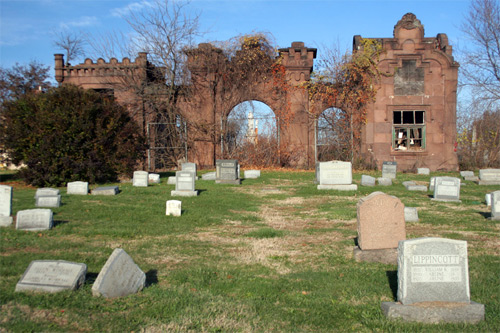
All told, Mount Moriah Cemetery is a fascinating place, for reasons good and bad. It's certainly a historic and cherished ground by some accounts, but by others, it
doesn't seem a very peaceful final resting place. Depending on how far you're willing to take the thought, it could even venture into the realm of whether permanent
physical space is still necessary for the disposal of dead people.
Which takes us back to the beginning of this piece, varying religious outlooks on the same subject, be it the historical significance of Jerusalem's Mount Moriah or
what to do with a human corpse. Not everyone agrees with cremation. (I suppose I would prefer being cremated, but only after science has taken all it needs . . . I
doubt it will have much use for my liver, for example.) Mummification is pretty impractical by modern standards. Cannibalism is generally frowned upon. Cremation
aside, that leaves us pretty much with burial.
With over 6 billion people in the world, let's estimate that half of them will be buried . . . that's over three billion plots of the earth that will be populated by
wooden boxes with corpses in them in the next 75-100 years. And how many more billion beyond that?
Whether they/we truly rest in peace is up to future generations. There's legal perpetuity, as Mount Moriah has and which prevented the construction of a Cobbs Creek
Expressway (I-695) in the 1950s, but even that can be overturned by the right politician's signature. (We've all seen Poltergeist, although honestly, what
were they doing staying in the house the night after the exorcism, other than to parade JoBeth Williams around in her underwear? Duh.)
What was it the big man said? In this world nothing can be said to be certain, except death and taxes. That's the one. Guess we should pick out our place
while there's still a place to pick out.
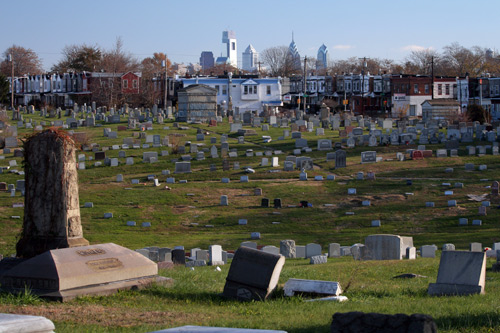
–B Love
|
11 December 07:
Our paper of record is either too scared or too invested
to call a Clusterfuck a
Clusterfuck
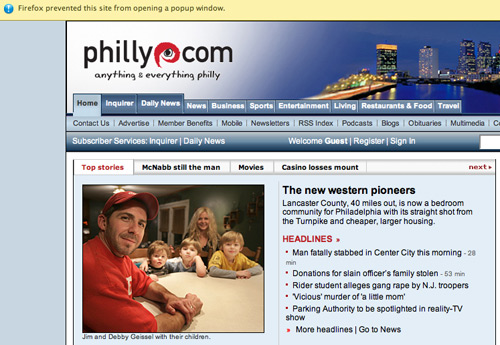
This is the top story this morning, December 11th, 2007. Not the arraignment of the man who brutally murdered the honor student. Not the alleged gang rape by the
state troopers. Not the "man fatally stabbed" story that was just changed from Center City to South Philly. If nothing else, it's nice to see a break from the "if it
bleeds, it leads" standard.
But this story, The new western pioneers . . . I can't believe that such a one
sided story is the lead on the region's most formidable news web site. That's the problem: not that this is news -- I'm fine with the continuing development of the
exurbs being news -- but that a story like this is presented so irresponsibly one sided, with no analysis, no challenges, no room for dialogue.
I have to state up front that I live in the city, and I love city living enough to have made an entire web site about it, with excellent contributions from the likes
of Nathaniel Popkin, who envisions what the city could be, and Steve Ives, whose point of view has been formed by years of riding Septa from a part of town
many won't visit. But I'm not so blind to think that everyone should, or would even want to, live in the city. Philadelphia has some beautiful suburbs, from Media
and West Chester to Haddonfield and Collingswood. And then there is the Main Line, its own amazing entity.
But, metropolitan Philadelphia has more than its fair share of sprawl, the too-big, poorly planned communities built for driving. Using code words and phrases like
"more for less", "comfortable" and "cute", and a closing line of "the housing is a lot cheaper here - and so are the taxes," Inquirer staff writer Tom Infield seems
to encourage more of it. I wrote Mr Infield to ask him why, and to ask why he didn't present any -- not a single one -- of the adverse effects of this. (So
far, no response.)
Is our energy consumption some pie-in-the-sky liberal joke? Is this article's placement on the homepage of Philly.com the paper's answer to Al Gore's acceptance of
the Nobel Peace Prize, which happened last night and which one would think would at least be front page news?
That was in 2004. After three years, Jim Geissel admits he is beginning to tire of his 64.5-mile commute "from the driveway to the front door of
Coca-Cola." But he says he's still glad he made the move. . . . Despite the extra tanks of gas and the wasted hours, the smaller mortgage and comfortable lifestyle
of Lancaster County make it worthwhile, he said.
. . .
When they moved in, Ron Bradley was a sales trainer in Conshohocken. He spent $5 on tolls and $12 on gas each day.
. . . Today he has a different job. As the regional sales manager for Zales jewelry stores, he still drives to the Philadelphia area, but he just as often goes as
far as downstate Delaware.
He said that every time he comes home and passes an Amish buggy, he's glad he chose Lancaster County.
TEE HEE HEE, they spend so much on gas, isn't that just a laugh! And I'm sure the Amish buggy driver returns the sentiment.
Concepts like global warming and energy dependence may have made it into the mainstream lexicon, but they're not taken seriously enough to be considered by a major
paper's writer of a story that directly contributes to both, much less that they'd lead anyone to reassess their lifestyle. Too often in modern America, it's me
over we, and that's precisely what's wrong with the angle of Infield's article.
Gas consumption and gas spending aside, how many questions should one person be left from one article? The word "sprawl" doesn't even appear in the article. Instead?
This is often where tourists coming to see the Amish farms or visit the outlet malls of Lancaster County get off the pike.
. . .
Dave Royer, director of transportation planning for the Lancaster County Planning Commission, says: "We seem to be becoming more and more - at least a portion of our
county - a suburb of metropolitan Philadelphia."
Okay . . . but how does Dave Royer feel about that? What about this farmland that draws tourists? Is it not being chipped away as development after
expensive development pops up?
Any mention of race? Nope. Well actually, sort of:
"You have problems everywhere you go, but it seems the problems out here are on a smaller scale," he said.
"And they happen less," Cathy Bradley said. "People out here are involved in other people's lives, so you don't deal with the problems alone."
Derrr what? What does that even mean?
And the houses themselves?
Noelle Fortna, an East Cocalico supervisor, said a lack of public water services was holding back housing growth in her area. Once that is dealt with,
she said, more developments are likely to pop up.
Awesome! Because, as we all know, the supply elsewhere in the region is at capacity, right?
"Everything was very expensive - and the houses were all outdated," Debby Geissel recalled.
. . .
The price was $238,000, much less than the $300,000 they had expected to have to pay for a lesser house dating from the 1950s or '60s in the area of Horsham, Hatboro
and Warminster.
A lesser house. From the godforsaken 50s and 60s, when people apparently didn't know how to build a home that would last.
Pardon me for being a dumbed down consumer, but what I've learned from Tom Infield's article is that houses built decades ago are disposable, that 64.5 mile commutes
-- each way -- are doable since this one dude is doing it, that -- holy shit! -- houses are cheaper the farther out you go, and the tradeoff is so worth it, and that
there is no such thing as sprawl.
I forwarded this story to Jim Kunstler, author of The Long Emergency and The Geography of Nowhere (one of my all-time
favorite books), and whose blog is called Clusterfuck Nation (hence the title of this post) to
see what he thought. He wrote back:
Brad--
The mainstream media is especially brain-dead on the implications of our energy predicament.
In any case, i serenely believe that the housing bubble crack-up is the end of the grand cycle of suburban development. Only a few twitches left in the
corpse.
Jim
"It's All Good"
It's all good, all right.
Google Maps, whatcha got on Ephrata, the focal locale in the article?
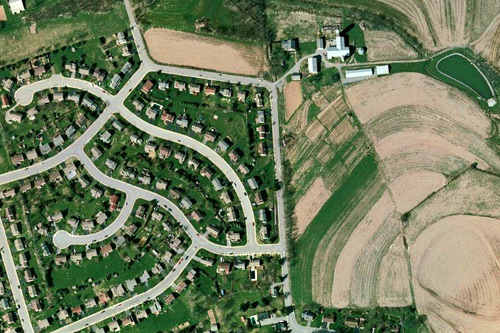
Farms to development: "eat me."
Please understand: this is not an anti-suburban rant, this is about what's right, or what's not, as it were. As I've mentioned, suburban living can be beautiful,
done right. (Just like urban living can be, and often is -- especially here -- done wrong.)
What I don't get here is why this particular, one-sided, borderline-advertorial touting these
hourlong commutes is the Inquirer's lead story on a day with so many news stories. Might it have anything to do with a story that ran four days ago -- Toll Bros posts first
quarterly loss in 21 years -- combined with the fact that one of said Toll Brothers, Bruce Toll, is the Chairman of Philadelphia Media
Holdings, the parent company of the Inquirer and Philly.com? (For more on this, revisit the Weekly's story from the time of PMH's purchase.)
Man, I don't know. I've asked Tom Infield directly, so I guess we shall see.
Damn.
–B Love
|
10 December 07: Wild wild west
Within a day of each other, Iron Mike Burlando and Gene from the USPS (via Tacony) each emailed me about various West Philly goings on, Mike about the Radian and
Gene about the old post office grounds where Cira Centre South will probably happen. It dawned on me that (not counting the Plateau) I've only been west of the
Schuylkill twice in the past several months, once to get to Upper Darby and once to get to Kingsessing. Sorry about that, West Philly heads . . . I've done my part
by keeping We All Belong in heavy rotation.
So anyways, if we'd have an official Philly Skyline look at West Philly goings on, it would look a lil' something like . . .
POST OFFICE ANNEX DEMOLITION:
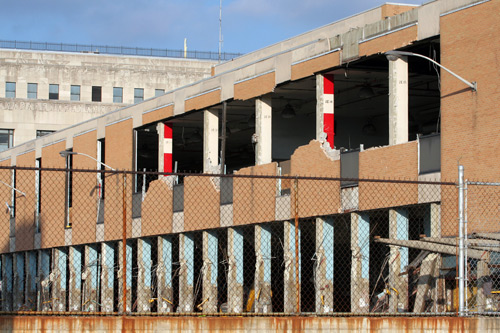
As mentioned quietly a couple weeks ago, ground on the first phase of the Cira Centre South project has been broken. But, given the amount of demolition that has to
happen first, namely to the US Post Office annex, it'll be a while before we see even the parking garage. But hey, that demolition is a-moving. The photo above is
the western side of the building.
The photo below shows the building in relation to the Northeast Corridor tracks used by Amtrak. This is the part that would look awful nice covered up with a plaza
or promenade to make Cira Centre South the true gateway between University City and Center City.
[Penn Connects: Cira Centre
South.]
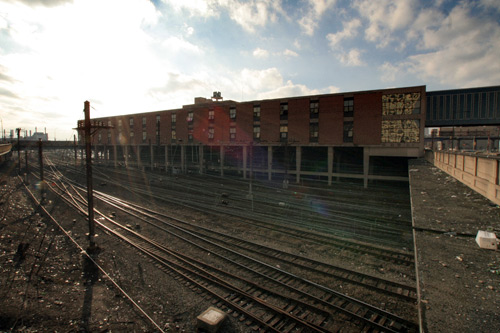
* * *
THE SCIENCE CENTER:
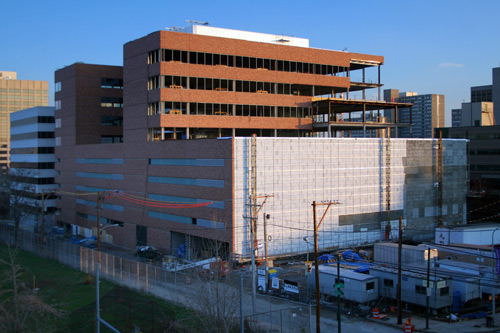
The northeast corner of 38th & Market is the site of the first major cog in the Science Center's multi-billion dollar master plan to fit out the Market Street
corridor between 34th & 38th -- conveniently located smack between Penn and Drexel -- with enough office and lab space to host scores of high tech (read: biotech)
companies. This building, designed by Portland's Zimmer Gunsul Frasca Partnership, is topped out and should open in 2008.
[ScienceCenter.org.]
* * *
THE RADIAN:
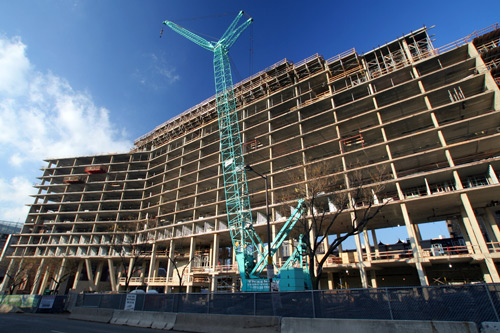
Out at 3925 Walnut, construction on the finale of the Erdy McHenry College Trilogy is ahead of schedule. The Radian is Penn's answer to Temple's Edge at Avenue North
and Drexel's Race Street Dormitory. All three are dual-winged, all three are silver, and all three are between 11 and 14 stories. Whatcha got up there, LaSalle?
Like Avenue North, the Radian is situated in an off-campus center of activity, this one 40th & Walnut, with the Bridge cinema, Fresh Grocer, Philly Diner, Mexicali
and its enormous guacamole burritos, the 40th Street book/record/head shops and the three highrise dorms across the street. It's supposed to open in August, just in
time for fall semester.
[Radian Apartments.]
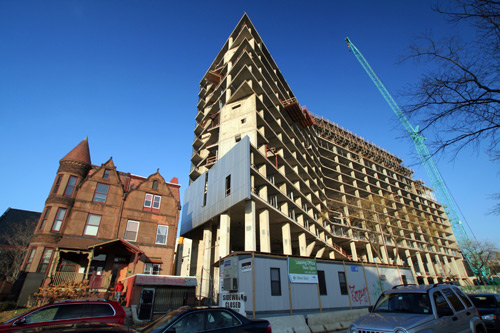
* * *
THE HUB ON CHESTNUT:
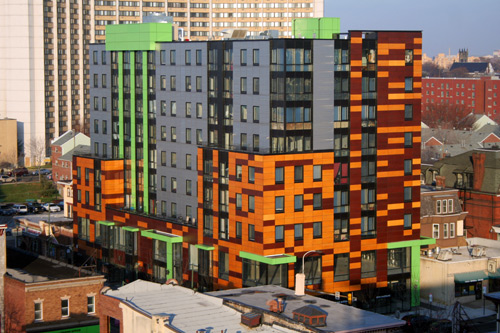
Just up the block at 40th & Chestnut, the silver, chartreuse, orange and chestnut Hub is already open and rockin' and rollin'. It is supposed to be the first
building in a multi-phase project called 40th Street Promenade, but there's no word yet on when the second phase will begin.
[The Hub on Chestnut.]
* * *
Welp, that's what's up on West Philly Skyline today. Two other adjacent projects without updated photos to mention: UPHS' Perelman Center for Advanced Medicine is moving along and will open next summer. Right next door, the Proton Center now has a name on it: the
Roberts Proton
Therapy Center, named for Comcast's Ralph Roberts and his son Brian Roberts, who donated a large financial gift to assist in construction.
Philly Skyline West Philly Skyline, take us on home.
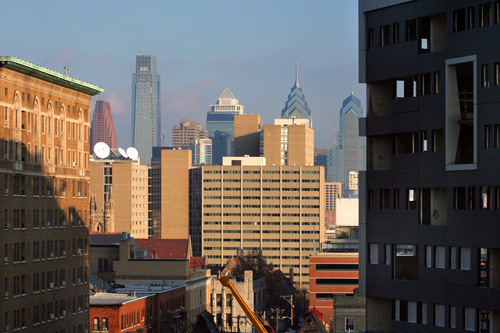
–B Love
|
   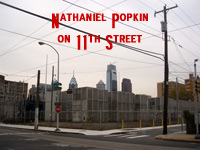
9 December 07: Ritz/Murano/Comcast Triple Play
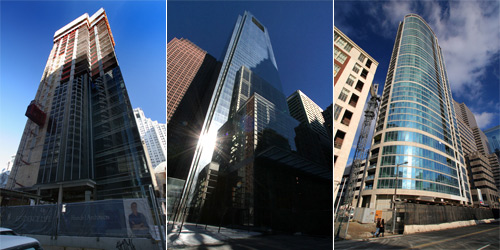
Already being the ninth of the month, the Residences at the Ritz-Carlton and Murano updates were handled a little more like slowskys than with stupid fast, but who's
keeping track (other than the guy who sends anonymous one-line emails saying "better Murano updates, please")? So hey, whattaya say, forget about the Eagles and have
a look at the photo updates 'round the way.
* * *
For something totally unrelated . . . if Vincent Gallo is on your radar and you are upset that you were unable to see his new band (with the so-awesome name
RRIICCEE, which I can only imagine is pronounced "Ricci", as in Christina, his costar in Buffalo 66, the first of his two major movies about his own penis) tonight
at Johnny Brenda's, then perhaps this YouTube segment of a 1984 episode of Graffiti Rock will suffice. Prince Vince and Run-DMC . . . you kiddin' me?
–B Love
|
   
7 December 07: Kind of blue
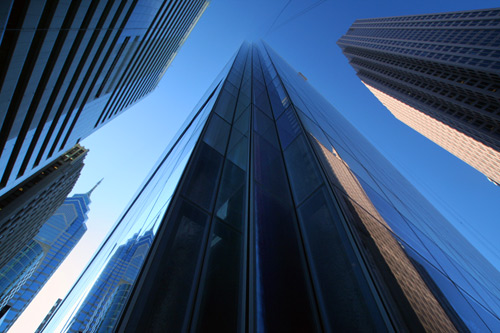
Hey now, was yesterday a great day to put In Rainbows (2) on your headphones, bundle up and just go walking? Yes, yes it was. One of those
witch's-teat/perfect-clear days with those blue skies your circular polarizer loves so much, y'know. With all this in mind, the Philly Skyline Comcast's Open
Skyline above is one of a set of 15 new photos in the Comcast Center construction section, so have a look if you like.
* * *
Looking around at what's what, the following two items are what's what on this chilly Friday 66 years removed from the bombing of Pearl Harbor.
- CASTLEWAY, KLING, RITTENHOUSE SQUARE AND THE FIRST RENDERINGS AND REACTION: First, some sour grapes: the brothers Ween sang 15
years ago "you get burnt for playing by the rules." And how. Your friendly Philly Skyline has for at least three weeks been sitting on about a zillion awesome
architectural renderings by KlingStubbins of Castleway's much-anticipated plans for the former Parking Authority lot on the 1901 block of Walnut Street, the
northwest corner of Rittenhouse Square. Being the proper fellows we are, we asked permission to use some of the photos and offer up a feature on said project. We
were advised that it was a good idea, but to please wait.
Well hey, whattaya know, those images appear in two separate columns today: Inga's weekly Changing Skyline
column, which makes some excellent points regarding the ground level use of an otherwise excellent looking hotel-condo tower, and Matt Blanchard's Plan Philly column, which looks more at the existing properties along Sansom Street that may require
demolition in order for the project to move forward: the Bair Funeral Home, the Rittenhouse Coffee Shop, and the Warwick apartment building, the five story building
abutting the 20th & Sansom parking lot. They're both great reads.
As soon as B Love stops being a whiny little bitch, Philly Skyline's Castleway write-up will be ready to roll.
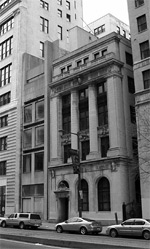 NORTH BROAD STREETSCAPE AND WHAT THE CONVENTION CENTER'S EXPANSION COULD DO TO IT: Speaking of Inga and Matt Blanchard, Matt is on top of what boils down to the Convention Center Authority's assessment that the Philadelphia Life
Insurance Company Building and its 1960s addition being met with the wrecking ball (the one that's already leveled a number of buildings between 13th & Broad, Arch &
Race) because of the Pennsylvania Historical and Museum Commission's (PHMC) uncertainty on whether to preserve them despite there already being an agreement
in place to do so. Inga, you might recall from her September
14 column, detailed why the buildings are important and how they went from being saved to not being saved and replaced by a boring block-long wall of glass.
NORTH BROAD STREETSCAPE AND WHAT THE CONVENTION CENTER'S EXPANSION COULD DO TO IT: Speaking of Inga and Matt Blanchard, Matt is on top of what boils down to the Convention Center Authority's assessment that the Philadelphia Life
Insurance Company Building and its 1960s addition being met with the wrecking ball (the one that's already leveled a number of buildings between 13th & Broad, Arch &
Race) because of the Pennsylvania Historical and Museum Commission's (PHMC) uncertainty on whether to preserve them despite there already being an agreement
in place to do so. Inga, you might recall from her September
14 column, detailed why the buildings are important and how they went from being saved to not being saved and replaced by a boring block-long wall of glass.
Yesterday, Design Advocacy Group penned a letter to PHMC (also available at Plan Philly) urging them to stick to the agreement it signed and keep the buildings as part of the plan and, more importantly, as parts in the
Broad Street sum. Few are the places in Philadelphia where a 360° view provides such a range of architectural styles: the second empire City Hall (MacArthur,
1871-1901), the classic Masonic Temple (James Windrim, 1868-73), the Furness masterpiece Pennsylvania Academy of Fine Arts (1876), the gothic Arch Street United
Methodist Church (Hutton, 1870), Trumbauer's Hahnemann Hospital (1928), the beaux-arts Liberty Title &
Trust Building (Savery & Scheetz, 1929), the urban renewal Municipal Services Building and plaza (Kling, 1963), the, um, parking garage of Parkway (1990s), and these
two, the neoclassical Philadelphia Life Insurance Company Building (Lacey, 1915) and its modernist/brutalist annex (Mitchell/Giurgola, 1965). Perhaps only
Rittenhouse Square itself has a greater variation around its perimeter.
This is not a matter of standing in the way of expansion. Given that Sugar House and Foxwoods were each more or less green lighted by the state with an "FU, city"
attached to it this week, that's not even an option, and why would it be at this point? Preserving the buildings, if even just the façades, maintains a
certain node of Philadelphia's architectural heritage (Furness, Windrim, Kling and M/G on the same block? Invaluable.) and, more over, holds the state to task for an
agreement it already filed. A very close eye is being kept on this situation by a number of people, not least DAG.
(Inset photo of the PLICo Bldg is from Steve Ives' photo essay In the Way of
Progress.)
* * *
On the calendar front, I'd like to thank my man Mix D in Manayunk for the suggestion of a calendar preview. As I told him, I didn't have one before because I wanted
to keep the photos a surprise of sorts, but I then realized that just about every commercial calendar out there has a preview of its contents on the back. So in the
interest of adding some visual aid, the following two previews have been added:
A sample month from the calendar:
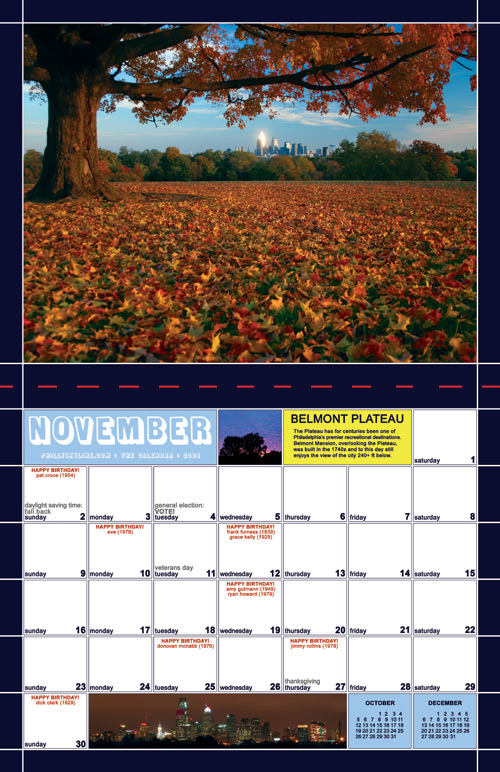
A preview of the images selected for the twelve months of 2008:
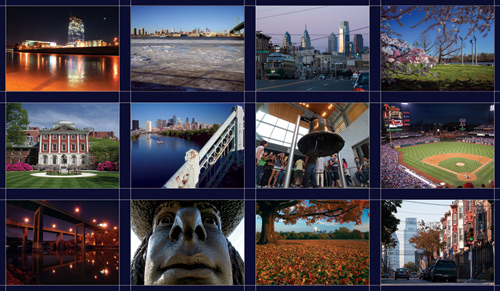
Hope you like. If you're interested in buying the calendar, it's a measly twenty bucks and it can be bought online (securely, via PayPal) on this web site RIGHT HERE. Or, you can buy it in person exclusively at Conspiracy Showroom, 910 N. 2nd Street in Northern Liberties, beginning December 15 --
plenty of time to buy it for the one you love (even if that person you love is you).
The night before that, December 14, is the official calendar kickoff. Details on that are coming.
–B Love
|
   
6 December 07: Yuletide Cheerios
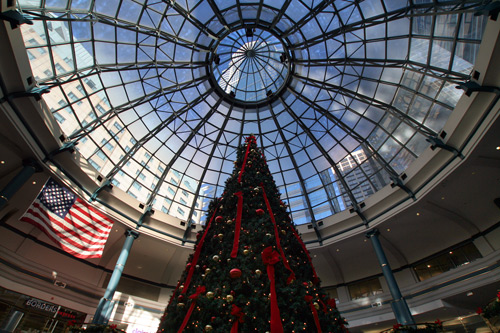
Reader Jeremy in Bensalem emailed over the weekend wondering what's been up with the lack of Philly Skyline Philly Skylines lately, and if there were any plans for
any Christmas in Philly themed editions. By jove, that's a holly jolly idea!
So with that in mind, Jeremy and Noël nerds, get in the spirit (might I suggest the holiday insta-classic by Fergie & the Black Eyed Peas the
Three Wise Camels HERE) and enjoy photo festivity oh seven. For our friends celebrating this third night of Hanukkah, you are not forgotten.
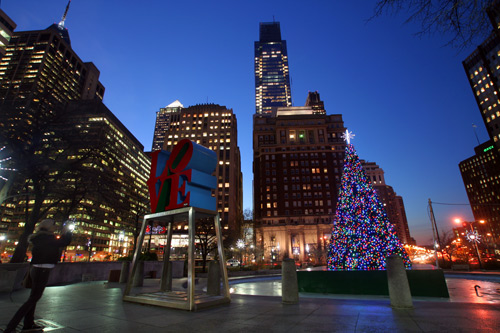
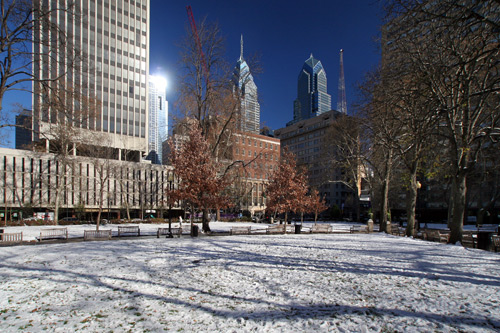
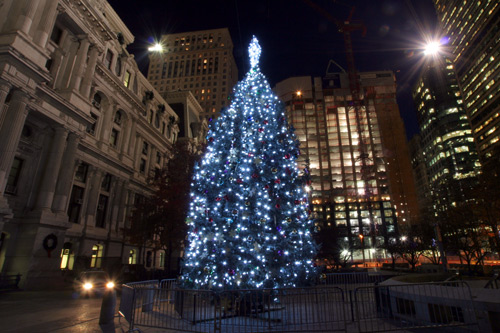
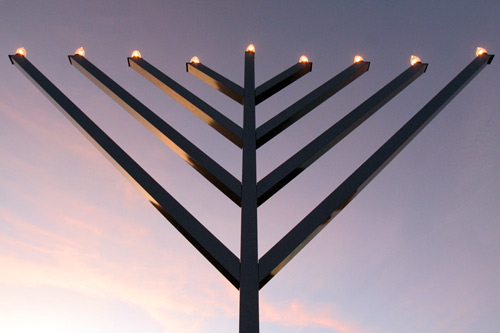
–B
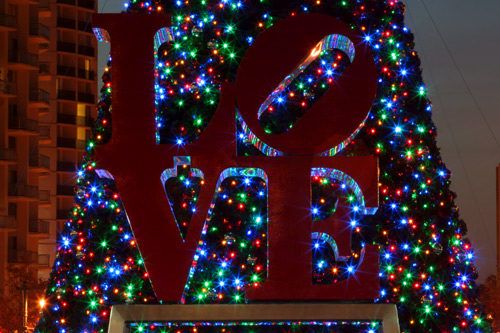
|
5 December 07: The Possible City:
Snake uprising
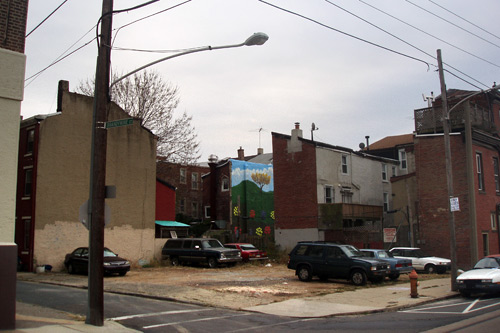
by Nathaniel Popkin
December 5, 2007
The King cobra, which smells with its tongue and sees clearly at night, is declining with the forests of Southeast Asia. Perhaps the other snakes in the region
see this as good news. The King, after all, is ophiophagous: it feeds mostly on those other snakes (even the venomous ones). We might call it a cannibal.
The Cobra highway light, that ubiquitous lamp so named for the curving shape of its neck, was introduced in 1957 by Westinghouse. The lamp they called the
Silverliner became the most popular street and highway lamp in America. That year, General Electric countered with its own Cobra-style lamp, the M400. Typically
posted 40-45 feet above the ground, the Cobra highway light was designed to make driving safer. But most cities, new and old, installed the Cobra everywhere: on
shopping and residential streets and alleys, on boulevards and parkways. In old cities like ours doing so meant removing cast iron and wooden street lamps and
replacing them with aluminum posts. Because the new lights cast so much light, they could be installed on just one side of the street, thereby saving municipal
funds. The lamps were efficient and easy to maintain.
Like their namesake, they were cannibals too -- and by the mid-1960s Cobras were king. But for islands of historic preservation like Society Hill, in most city
neighborhoods and downtowns the Cobra light had eliminated the old-style lamp. To be fair, cities like New York and Philadelphia began lighting the street at the
expense of the sidewalk in the late nineteenth century. But it's worth wondering if the swiftness with which the Cobra came to dominate the streetscape was the
result of the kind of reckless manipulation of government that General Motors used to obliterate the streetcar in favor of the diesel bus.
 One of the problems with using highway lamps to light city streets is scale. "We need to see where the light is coming from," says Tod Corlett, a professor of
industrial design at Philadelphia University's school of Design and Media. Corlett, the Venturi-influenced designer who has been retained by the East Falls
Development Corporation to design signage and other streetscape improvements, has a keen sense of how people engage in the urban landscape. "If we can't find the
light -- if it's way up there -- it makes us uncomfortable." Thus a 40 foot -- even a 25 foot -- lamp post is too tall for human beings. As a result, and because
the light from a Cobra lamp gets caught in the tree canopy, the city sidewalk feels unworldly, haunted, and unsafe.
One of the problems with using highway lamps to light city streets is scale. "We need to see where the light is coming from," says Tod Corlett, a professor of
industrial design at Philadelphia University's school of Design and Media. Corlett, the Venturi-influenced designer who has been retained by the East Falls
Development Corporation to design signage and other streetscape improvements, has a keen sense of how people engage in the urban landscape. "If we can't find the
light -- if it's way up there -- it makes us uncomfortable." Thus a 40 foot -- even a 25 foot -- lamp post is too tall for human beings. As a result, and because
the light from a Cobra lamp gets caught in the tree canopy, the city sidewalk feels unworldly, haunted, and unsafe.
At the highway scale, the Cobra light is symbolic of the way we value the driver over the pedestrian. The light bathes the carriageway, but often leaves the
sidewalk itself simply dark. Now imagine turning a Cobra light 180 degrees around. Magic. Now it lights the sidewalk; now working backwards imagine we lived in
a society that valued the sidewalk more than the street. What would that be like?
This question lit up Lewis Mumford's Underwood fifty years ago. In a classic New Yorker Skyline column, The Highway and the City, an angered and
jaw-droppingly precise Mumford predicted every destructive result of the then just-passed Interstate Highway bill. "For the current American way of life is
founded not just on motor transportation but on the religion of the motorcar," he writes, "and the sacrifices that people are prepared to make for this religion
stand outside of rational criticism." Indeed, predicting "the total defeat of the city itself as a place that offers the maximum possibilities for face-to-face
meeting, social cooperation, and transactions of every kind," he couldn't understand why every other diverse mode of transportation, including feet, was being
sacrificed for one, the automobile. Citing all the benefits we already know and the one most important for him -- efficiency -- Mumford says, "Every urban
transportation plan should, accordingly, put the pedestrian at the center of all its proposals . . . But to bring the pedestrian back into the picture, one must
treat him with the respect and honor we now accord only to the automobile: we should provide him with pleasant walks . . . It is nonsense to say that this cannot
be done in America, because no one wants to walk."
"Here's one more thing we need to do, maybe you've already thought of this," says Dennis McGlade, president and principal at Olin Partners, the landscape
architecture firm. The two of us are walking up Walnut Street the day before Thanksgiving. It's 60 degrees and the city is joyous. "Right now there is no one
thinking about you and me," he says. "There's a Streets Department that is supposed to cover the sidewalk but no Sidewalk Department that also thinks about the
street."
Just then I grab onto one of Paul Levy's Center City Luminaires, the now-ubiquitous hunter green Philadelphia street lamp. "This," I respond, "is a symbol of that
idea. This lamp illuminates the sidewalk primarily. As a byproduct it also lights the street." (Lighting experts say street lamps are more effective at lighting
the carriageway than Cobra lights because they are non-glaring and their light doesn't get lost in the tree canopy.)
City for people or city for cars?
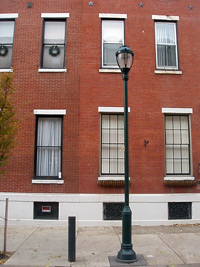 That's a question Levy, CEO of the Center City District (CCD), began tackling a decade ago when the first lamps were installed -- and the first Cobras were
unceremoniously toppled. Since then the CCD has installed nearly 2,100 lamps, including 92 now going up in Washington Square West and between the Comcast Center
and the Parkway. Levy's vision was immediately convincing. Center City was all of a sudden pleasant to be in at night. Soon, as the CCD expanded its lighting
program, others followed. The University City District, which has installed 300 lamps, is adding 84 more along Baltimore Avenue; Penn adopted a shorter Center
City hybrid lamp, Drexel the arms in the air lamp -- and other parks, bridges, institutions, and public spaces quickly followed suit. In my estimation, and
including the work of the CCD, since 1998 Philadelphia has replaced Cobras with about 4,000 pedestrian scale street lamps. All this has changed our perception of
the Philadelphia night. Now a cobra-lit street feels wrong: mottled, dark, uncertain, and sometimes, as in my own block, inappropriately bright.
That's a question Levy, CEO of the Center City District (CCD), began tackling a decade ago when the first lamps were installed -- and the first Cobras were
unceremoniously toppled. Since then the CCD has installed nearly 2,100 lamps, including 92 now going up in Washington Square West and between the Comcast Center
and the Parkway. Levy's vision was immediately convincing. Center City was all of a sudden pleasant to be in at night. Soon, as the CCD expanded its lighting
program, others followed. The University City District, which has installed 300 lamps, is adding 84 more along Baltimore Avenue; Penn adopted a shorter Center
City hybrid lamp, Drexel the arms in the air lamp -- and other parks, bridges, institutions, and public spaces quickly followed suit. In my estimation, and
including the work of the CCD, since 1998 Philadelphia has replaced Cobras with about 4,000 pedestrian scale street lamps. All this has changed our perception of
the Philadelphia night. Now a cobra-lit street feels wrong: mottled, dark, uncertain, and sometimes, as in my own block, inappropriately bright.
The uncertainty is telling, especially at this time of year, when darkness falls at 4:30. The air is chilled, Septa is lousy at night. If we go out, too-often we
drive; otherwise Philadelphia greets the dark winter with a wink and a "see you in the spring." The sidewalk, betrayed, is empty. The shopkeeper can't make it --
every aspect of city life suffers, but unnecessarily. It isn't that cold out. Appropriate lighting would not only light but warm our way.
Many over the years have proposed that better lighting would cut crime. All too often this hypothesis has been accepted at face-value and used as an excuse to
blast a cobra light into an area that didn't want or need it, turning a city neighborhood -- or a suburban parking lot -- into a kind of permanent crime scene.
However, studies over the years suggest that better lighting is effective. In order to come to a decisive conclusion, the British Home Office surveyed a bunch of British and American studies on the subject.
Their meta-analysis concludes that improving lighting can reduce crime by 20%; one study, indicating that lighting is an effective crime-reducer, says that by
lowering the cost of public safety, new lighting pays for itself in a year.
Proper sidewalk lighting makes the pedestrian feel at ease. "The street lamp is one of the things that defines the sidewalk. Of course at night it's the really
the only thing," says the industrial designer Corlett. Especially in Philadelphia, which lacks the scale of New York and its consistent retail presence (which
adds light and dimension), the lighting has to be right. When it isn't the problems of the streetscape are only amplified. When it's inconsistent and fragmented,
when the block you are on is well-lit but the next one isn't, the city seems to fall apart.
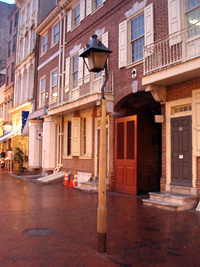 This is almost universally the case on the borders of parks and college campuses. Independence National Historical Park, which boasts several different
well-proportioned lamps, including the Old Philadelphia lantern with the natural wooden post, is properly lit. But walk on the street next to the park or between
its various parts and you're in Cobra territory. Nowhere else does the old Silverliner look more out of place! The same goes for much of Market, Chestnut, and
Walnut between Penn and Drexel, for some of the edges of Temple's campus, for many of Septa's stations and the vast majority of bus stops, for the entrances to
parks, including Clark Park on Baltimore Avenue, and most neighborhood squares and recreation centers. Only recently have the Cobras been removed from around the
four main squares -- leaving the sidewalk to the other, non-venomous garden-style snakes (if only these lampposts ate the rats!).
This is almost universally the case on the borders of parks and college campuses. Independence National Historical Park, which boasts several different
well-proportioned lamps, including the Old Philadelphia lantern with the natural wooden post, is properly lit. But walk on the street next to the park or between
its various parts and you're in Cobra territory. Nowhere else does the old Silverliner look more out of place! The same goes for much of Market, Chestnut, and
Walnut between Penn and Drexel, for some of the edges of Temple's campus, for many of Septa's stations and the vast majority of bus stops, for the entrances to
parks, including Clark Park on Baltimore Avenue, and most neighborhood squares and recreation centers. Only recently have the Cobras been removed from around the
four main squares -- leaving the sidewalk to the other, non-venomous garden-style snakes (if only these lampposts ate the rats!).
The reader ought not think I don't like darkness, or shadows. (I am a writer, after all.) Dickens, whose love of the night city ("I wrote very little in Genoa and
thought I had avoided traces of its influence -- but, good God, even there I had at least two miles of streets by the lights of which I could roam around at night,
and a great theater each evening.") made him something of an English flaneur. He saw all the urban layers, perhaps those most of all darkened by coal and
poverty and prison. He would have hated the Cobra's blitzkrieg. My plan is thus meant simply to comfort and warm the pedestrian.
But we need to admit that much of rowhouse Philadelphia, lacking retail lighting even at most corners, where most building owners don't turn on their front door
lamp, where porches and in-set front doors create more shadows, where abandonment amplifies the problem still, where Cobra lights on too-tall and therefore leaning
aluminum posts reinforce the feeling of decay, is dark and foreboding at night, a night that right now lasts nearly fourteen hours. These sidewalks are empty and
they need not be.
They must not be, if we imagine the city should be full of life.
They ought not be if we are sure the city is an antidote to our culture's atomism.
Proper lighting is not the only solution, but it's a necessary one.
We ought to start with retail blocks. Of course many concentrated retail locations -- K&A, Broad-Erie-Germantown, Broad and Snyder -- are lit. But here again
it's the kind of light that makes you uncomfortable. It also makes those locations disconnected. Rather the strategy has to be to knit together the entire city.
Consistent lighting may do just that. We voters just passed a referendum assigning a lot of debt to commercial corridors (a terrible name suggesting the way urban
life has become so segregated, I think); it isn't clear if there is funding for lighting. Nevertheless, a first phase might install the Center City Luminaires on
50 retail blocks in the expanded Center City (Passyunk Avenue, Fabric Row, Lancaster Avenue, throughout Old City, 2nd Street in the Northern Liberties, Girard
Avenue come quickly to mind). This would cost about $8.2 million, a reasonable sum that would effectively expand the range and feel of the center. Cohesion of
well-lit blocks being so important, placement of new lamps could be optimized by connecting to existing lamppost locations.
Tod Corlett and I were standing outside the Philadelphia University architecture and design center when we spoke about lighting. We were both holding cups of
coffee. See this, he said, pointing to the well-proportioned but faux-nineteenth century street lamp along the campus path. "They wanted Ivy League," he said,
"or what might like something out of Dickens. We told them that's not what a design school should look like. These used to be globes," meaning they were
contemporary lamps from the 1970s. He told me he was similarly disappointed in the choice of lamp for the Avenue of the Arts.
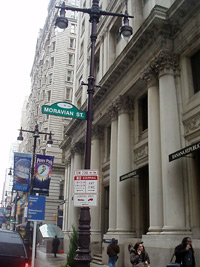 "They're turn-of-the century," I said. "Replicas."
"They're turn-of-the century," I said. "Replicas."
"They're the admission that Philadelphia's best days are behind it, not ahead."
It'll be true if we keep thinking that way, no doubt.
So we serve ourselves well if the new lamps are of contemporary -- or at least not falsely historicist -- design. The Center City lights are traditional but don't
find it necessary to announce themselves as so. That's one reason they feel so good. But one way to subvert the instinct to historicize is for the city to hold a
design competition. New York did just that -- though I haven't seen the winner. But it
would be a mistake to design one kind of lamp. Actually Philadelphia needs lamps of two sizes -- one 14-foot for avenues and main shopping streets and another of
10-foot for rowhouse streets and parks (the existing alley light could remain) -- and perhaps several designs to fit diverse locations. There ought to be another
distinct lamp to illuminate transit stations, but that's a subject for another time. In some intimate blocks, the city might want to experiment with illuminated
bollards (like those on Market Street in the business district west of City Hall) instead of lamps and/or placing the lamps in the traditional placement up against
the building.
Tod also warned me about quality. It will be easy -- tempting -- to cover more territory with cheap lamps. But street lamps, fiercely contemporary or
revisionist, have to take a beating. Surface looks aren't enough. That's one reason I like the Center City Luminaires; they've held up great. Venturi's Manayunk
lamps haven't -- and the pedestrian can feel the difference.
If we spend $15 million each year for the first three years of the Nutter administration lighting the sidewalk, we'll cover 270 blocks with good-quality,
pedestrian-friendly lamps; the city will at once feel bigger (and more intimate thanks to the more-humane light), more cohesive, safer, and more open. Imagine if
Germantown Avenue, that most complex, undulating street -- that stretches and ranges across so much well-trampled territory -- was lit altogether, consistently
(but not necessarily with the same lamp throughout), with handsome, forward-looking respect for the walker. Now that's significant habitat loss for the King
cobra, whose days we have to hope are numbered.
–Nathaniel Popkin
nathaniel.popkin@gmail.com
For more on The Possible City, please see HERE.
For Nathaniel Popkin archives, please see HERE, or visit his web site HERE.
|
5 December 07: The Streetlamp Survey
by Nathaniel Popkin
December 5, 2007
Here are Philadelphia's street lamps, old and new -- and (many) new ones that are meant to look old. The issue of false historicism is an important one,
especially in Philadelphia when it is so often appropriate to use period lamps. But sometimes it isn't -- case in point Love Park -- and only reflects the easiest
reflex to hope for yesteryear. That's a dangerous proposition, which tells of insecurity and lack of confidence.
Still, there's enough ambition here. Temple University, especially, which blankets its campus with light, employs several contemporary lights. Manayunk, Penn,
Jefferson, Drexel and Independence National Historical Park do too. What do you like? My contemporary favorite is the arms-in-the-air lamp, two versions of which
we see here, one at Drexel, the other near the Constitution Center.
This isn't an exhaustive survey. I didn't get everywhere -- and I only repeat a few. However, many of the lamps pictured here are used in various locations. I
show the Center City Luminaire several times because it's used from Center City to University City to Germantown. I show the white top lamp used in Chestnut Hill
-- but also throughout the city; and several versions of the alley lamp. I was exhaustive on the true period lamps -- near the Second Bank of the United States
one can find four or five slightly different lamps and altogether throughout east Center City there must be a dozen similar lantern styles. But if you look
carefully you'll notice the differences.
Photo and technical credit to my friend Jeff McMahon.
Click to enlarge:
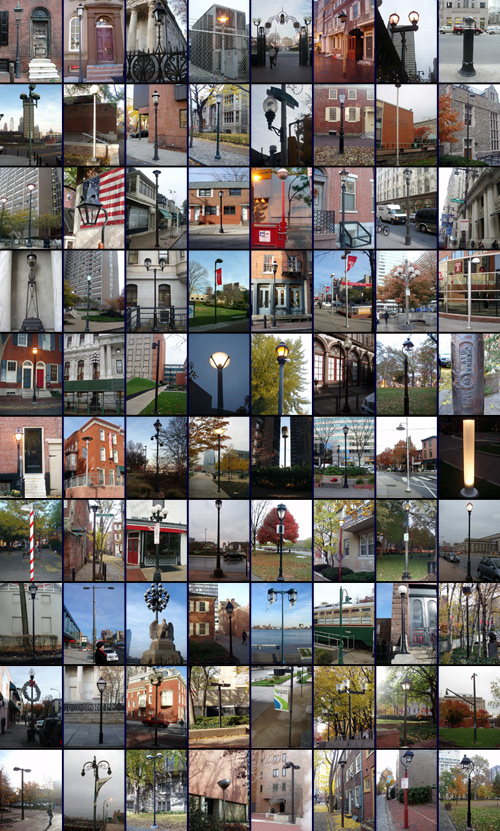
–Nathaniel Popkin
|
   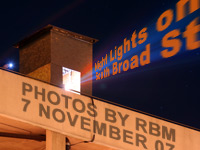
4 December 07: At long last: Return of the Calendar
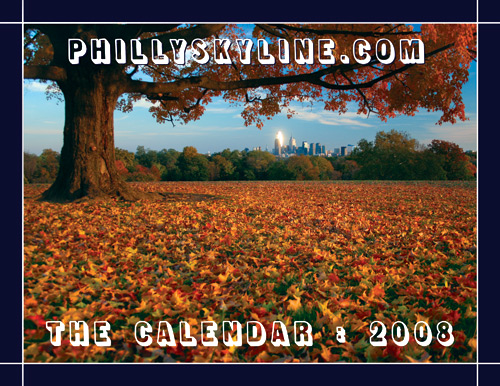
Man, if there's one time a year I wish I could bring the Cherry Hill Triplex guy on board, it's now:
NO CREDIT? NO PROBLEM! YOU'VE GOT TO BE CRAZY NOT TO BUY THIS CALENDAR! WHY AREN'T YOU HERE NOW? THE FUTURE IS HERE NOW! YOU CAN BUY THIS CALENDAR . . . ON
YOUR
And so forth.
But yes, it is true, dear friends, Philly Skyline, The Calendar: 2008 is here and (almost) ready for consumption. It's at the printer and will be
here in time both for a party and for the holidays. Details on the party are developing, but I think it's safe to circle next Friday the 14th on your Philly
Skyline, The Calendar: 2007.
The Skinny on the 2008 calendar:
• It's glossy.
• It's 11" x 17" (or 8½" x 11" times two, vertically).
• It's full of original photos, which in a sense amounts to a dozen 8x10s you can frame when the month is out.
• It's the only place you'll find all the Philly info and birthdays you absolutely need in 2008.
• It's only twenty dollars!
On that last one, it's true, it's a little more than last year's was, but there are two very important reasons for that: 1. Printing costs have gone up this year
(sheesh, has the American dollar gone down or is there a war going on that's causing trickle down gas price problems or something?) and 2. It's better than last
year's.
Anyhoo, keeping with the numbering theme, your choices to buy Philly Skyline, The Calendar: 2008 are two: 1. You can buy it in person at Conspiracy
Showroom after December 14 (yeah I realize that's cutting it close with Christmas, but in the internet age, 11 days is like forty years) and 2. You can buy it
RIGHT HERE on da Skyline. All online payments are made through PayPal, the standard, trusted payment source on the "internet". Shipping is a measly three dollars
and covers the super protective mylar envelope and hauling my lazy arse to the post office.
So there it is: Philly Skyline, The Calendar: 2008. It's a good time, it takes up little space on your wall/cubicle/desk/bare chest, it keeps you
organized and informed, and it's only twenty beans (plus three more for shipping). Help us help you. Buy Philly Skyline, The Calendar: 2008.
To pre-order the calendar (target first ship date: December 15 -- you WILL get it before Christmas Day as long as you order it before Friday the 21st -- that's 17
days to get the best Christmas gift in the world), just click here:
Thanks everybody, and stay tuned for launch party details.
–B Love
|
4 December 07: The Possible City:
A Junction that ought to be
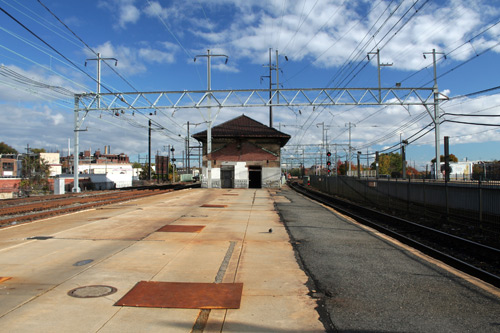
by Nathaniel Popkin
December 4, 2007
As I see it, the Winter King tree proves there is fierce life in death. No more really needs to be said on the subject. The day I saw a group of them, they were
nestled at the edge of the park where it gives off to the highway on one side and city on the other. There are three wonderful things about that tree, a Hawthorn
variety: its pale gray bark now leafless, its goblet shape, and its fiery berries. The first two -- the bark and the shape -- form a composition as moving as an
olive tree in a Sicilian field (minus the blue of the Mediterranean); the third is the glory: clusters of red berries as certain of life as the first cherry
blossoms of spring.
"I love these trees," says Majeedah Rashid, the Chief Operating Officer of the Nicetown Community Development Corporation. Rashid comes across immediately as a
person to trust. She is open and honest about the neighborhood's prospects and at the same time it's impossible not to recognize her enthusiasm. Her eyes burn as
brightly as the sun trapped inside the Hawthorn berries. Her certainty is convincing.
I've asked Rashid to show me around her neighborhood that is divided twice -- by Germantown Avenue and the Roosevelt Expressway -- and otherwise hemmed in by CSX
and Norfolk Southern and Septa's regional rail tracks (Nicetown is bounded by track on the west, Hunting Park Avenue on the south, Belfield Avenue to the north,
and Broad Street). The CDC was started in 1999 and Rashid was hired in 2002 in part to stitch it back together. The Boulevard, particularly, has left a tear in
the urban fabric. "When I started here, I looked on old maps," she says as we walked below the highway. "These were all streets. Cayuga ran right there." Since
then, the CDC has commissioned three planning studies; now Septa will spend $20 million to restore the Wayne Junction regional rail station on the neighborhood's
western edge. And that project has Rashid thinking not only about stitching her own neighborhood together, but the power the restoration project will have to sew
Nicetown to Germantown -- and the entire area to Center City. Right now the station is a barrier. "Our people don't even use it -- they're afraid," she told me
while we spoke in a conference room on the second floor of the CDC's offices on Germantown Avenue.
The potential to leverage Septa's investment hasn't been lost on the City Planning Commission. District planner Jennifer Barr, who community members call one of
the City's most capable, has begun a massive transit oriented development (TOD) study for all of Germantown. TOD refers to tools a city can use to encourage
density and pedestrian uses -- in other words to capture transit and its related foot traffic as an asset instead of the usual liability. It's old-fashioned land
use for the age of melting ice caps. The City's plan will be to reorganize the uses around the station to make it a more attractive place to live, encouraging
retailers and other employers to group around the station.
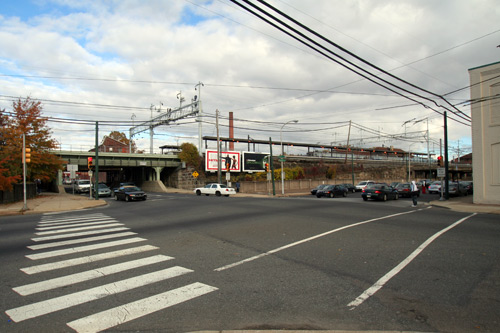
It couldn't be a better time -- or a better place. Philadelphia needs to overcome a pair of post-industrial obstacles. One of them is to find ways to better
integrate existing transit infrastructure into the flow of the contemporary city. The other is to stabilize and grow poor, predominantly minority neighborhoods.
Wayne Junction just might be the best example of Philadelphia's potential in this regard. Regional Rail routes R1, R2, R3, R5, R7, and R8 all run through the
station, though not all trains stop. Enough do, however, to make this one of the few Regional Rail stations to be able to operate something like a subway, where
the rider doesn't have to depend on a schedule, especially if heading south, toward Center City. Septa trains in both directions stop here 188 times a day; that's
somewhat less the 271 Broad Street Subway trains that stop at Hunting Park Station, on the east edge of Nicetown. A Regional Rail train from Wayne Junction
arrives in at Market East in just 12 minutes, however, slightly faster than the subway from Hunting Park to City Hall. Septa has the choice to increase service to
the station; doing so would obviously enhance its role as a hub. Critically, the 23 bus, the city's busiest, stops in front of the station; two others stop here
too, the 53 and the 75, which traverses Wyoming Avenue, connecting Wayne Junction to the Broad Street Subway and the Market-Frankford Line.
What's at stake isn't just to make the most of a Regional Rail system that by definition -- heavy rail -- is clumsy and hard to use as rapid transit (a subject for
another day), but to realign existing neighborhood assets for the benefit of the city as a whole. Germantown, which begins on the west side of the station, is a
relatively stable place. It's therefore feasible to imagine careful public sector investments paying off. LaSalle University, in the part of Germantown just to
the north of Nicetown, has pledged to invest there (if LaSalle is serious, this too is a subject for another day). Successful TOD around the station would
therefore leverage these strengths, potentially filling a hole in another Philadelphia donut, that the stretch of Germantown Avenue between Logan Street and
Hunting Park Avenue.
"We have to keep it real," Rashid cautions me. "Our first priority is to stabilize the commercial area." Rashid talks with her hands -- and to illustrate she's
pushing them gently down, as if to say "a little at a time, a little at a time." She's wise enough to realize it's impossible to reverse 60 years of
deindustrialization with smart ideas. Rashid is also careful to traverse the political field. It's clear she's had some success with Mayor Street, whose curfew
program the Nicetown organization has made it into a beacon of community trust. "We love it -- it's absolutely working," she tells me, especially because it has
fertilized positive relationships among adults, youth, and the police. But she's overjoyed with prospect of Michael Nutter as mayor. "He's something else," she
says and smiles with glee.
The Nicetown CDC will build a four-story, 37-apartment unit complex on Germantown Avenue, one block from the station. The complex will have three retail spaces --
for a Laundromat, cleaners, and the Paradise Café, and a community center. The design will meet some green goals. The funding for the project is much is
place. "I'm telling you, it's going to be the catalyst," says Rashid. Now I see the visionary, who understands so well how and why cities work -- and who knows
that it's incumbent upon her organization and the others in the community to leverage the renovation of the station. Thus her Germantown Avenue plan runs through
Nicetown, under the train trestle, and up to Berkley Avenue on the other side.
What about the 4400 block of Germantown? That's the block between the Nicetown CDC project and the station -- perhaps the most critical to connecting the
community to the station. Rashid explains to me that it's out of her -- and the community's -- hands. Councilwoman Donna Reed Miller has brought the developer
Herb Vederman to build on the land NTI cleared the year before. Vederman has a formula for inner-city locations like this one -- tight profit margins! -- that
don't involve community input. Still, she tells me the councilwoman has been a partner, and receptive to her organization's plans, especially recently. Having
been in her shoes once before I can hear the sound of vision being squeezed by narrow and supposedly powerful interests engaged in donkey-trading. Vederman is
Governor Rendell's former Deputy Mayor for Economic Development; his son Jay runs the business and Councilwoman Miller wants a deal.
The Philadelphia squeeze aside, Rashid is a capable consensus-builder. Nicetown Park, with the iconic contemporary sculpture on Germantown Avenue, is the
neighborhood's central public space. A few years ago she moved the August Nicetown Festival there; now the Community Design Collaborative, lauded by Rashid, has
produced a pair of plans to improve the park and other neighborhood areas under Roosevelt Expressway.
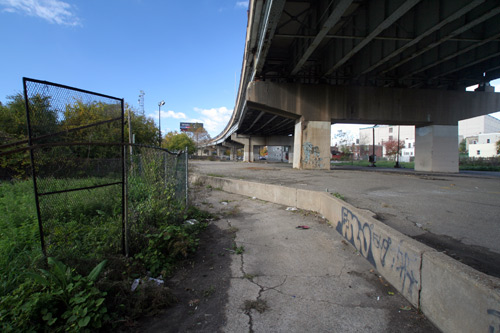
Her favorite idea -- "a concept so beautiful," she says -- is to build a skate park using the existing highway pylons. When one of the community members
originally suggested the idea it wasn't well-received. But he persisted and finally the task force assembled to work the with the Collaborative's design team came
to see the skate park as a way for the neighborhood to build on its strengths -- and to turn an obvious liability into a source of pride.
You don't have to look hard around Wayne Junction to find urban assets. As the Planning Commission's Barr explained to B Love, Steve Ives, and me, the station
itself, built in 1881 and then rebuilt under Frank Furness' eye in 1900, contained a waiting hall and a baggage room. Both will be restored to their dark-brick,
fleur-de-lis ambition. The station, which also includes a 1930s tunnel across freight tracks, is a gem of the bourgeoisie -- as is so much of the area: exotic row
houses with in-laid decorative crests, generous porches, front gardens, and lampposts. In our trek around the station, B Love and I found ample row house blocks
on both the Nicetown and Germantown side largely intact and brimming with architecture. West of the station, where Wayne Avenue heads into Germantown, are blocks
of boxy stick-Victorians -- singles and twins -- and the wonderful Zeralda Street, perhaps the most colorful in Philadelphia.
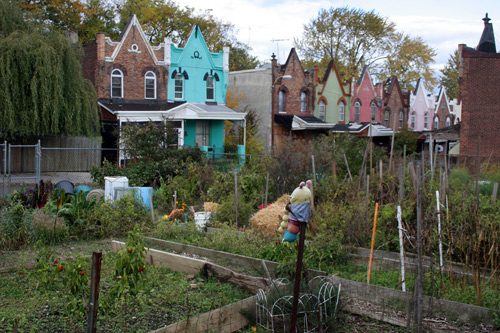
There are cobblestones and parks -- both Fern Hill Park, cut in two by Roosevelt Expressway, and Stenton Mansion Park provide ample recreation and natural beauty
within blocks of the station. Loudoun, the haunted mansion built by merchant Thomas Armatt in 1801 high enough on a bluff that he could see his ships coming into
port, stands on several lush acres just above the station. Stabilized after it was hit by lightening in 1993, it's a charming, but empty, piece of early
Philadelphia looking for a use. Stenton is the Georgian house built in the 1720s by Philadelphia's first cosmopol, James Logan, Penn's secretary. Stenton, a
working house-museum in a park just northeast of the station, is the real deal, with ample ambition to become a major tourist site.
Septa, with the station itself and two enormous shops, is the area's largest landholder. I spoke with Michael Dawkins, the transit agency's assigned community
representative. I wondered if Septa had thought about leveraging its station investment. Dawkins, who had just survived the project's first community meeting,
told me that the station upgrade was strictly a Septa project, that the project manager had hoped to be more ambitious but that it wasn't likely, that Septa hadn't
yet convened representatives from the city or CSX, the freight rail, and was unlikely to upgrade the public areas around its two shops. "The sidewalk on Roberts
Avenue," I protested. "It's dangerous."
"I know," he responded, "but . . . I have to get the station clean. They told me it was filthy."
"I heard they were pretty upset about that."
"I've got to get it clean. But I think if we build it they will come," he said, and repeated the mantra several times. Dawkins was patient with my phone
questions.
"How about lighting, signage?"
"Oh, yes, of course."
"And integrating the bus lines?"
"We plan to try to turn the 75 bus so that you won't have to cross the street to board."
"But you say it's a multi-modal system."
"Our main objective is to uplift the community by revitalizing the station . . . People see dollar signs . . . It can be a collaboration . . . .We probably need to
reach out."
Then he asked if I had any ideas.
Don't laugh -- we're about to waste $20 million in tax dollars unless Septa opens itself to the community, proactively collaborates directly with City agencies,
including Streets, the Planning Commission, Commerce, and possibly the RDA. If this remains strictly a Septa project it will fail.
This is why Barr of Planning Commission is pushing hard. She sees just what has to happen -- the junk yard and the gas station just behind the station have to be
moved; the storage building just across Windrim Avenue from the entrance should be renovated for mixed-uses. The strip mall at Windrim and Wingohocking should be
redeveloped for pedestrians. As a junction the station fails; for the trestles it's now a barrier, as is the Expressway. To overcome this we have to light
the underpasses. Christina Weiss, a student I worked with this semester in an industrial design studio at Philadelphia University proposed a solar-powered fiber
optic light for Germantown's train trestles. It lights up playfully mimicking the stars above. There's much to do. If I was Septa I'd pledge to keeping a ticket
office open all hours, installing a message board indicating the next train, and what track, allowing vending along the station's edge on Windrim Avenue, and I'd
experiment with a free transfer from Regional Rail to the 23, 53, and 75 bus. All this requires vision and coordination . . .
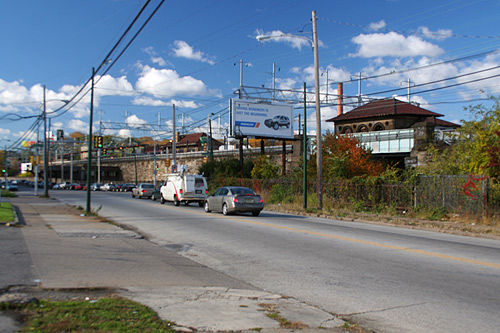
I was sitting in the Nicetown CDC conference room with Majeedah Rashid when she told me about the curfew program. The program is a Street initiative implemented
by his wife Naomi Post's organization Safe and Sound. It works like this: a child in Nicetown who is out past curfew is picked up by a police officer and brought
to the CDC office, where several staff members and volunteers make the child feel welcome. He is processed without being threatened. Problems if they exist --
whether school truancy, mental health, poverty, lack of heat in the house, poor diet, drugs -- are identified and the child is referred to the correct agency. All
services are available to the child who because the program is so carefully designed doesn't realize he is being assessed. His parents are called; in the meantime
the child is surrounded by community members, mentors, a police officer. He is fed. Rashid calls it a village. It's so effective that parents who arrive angry
often come back themselves to volunteer. Now let's imagine that child is a place, a junction that isn't but ought to be. "Let's all get together," says the
community leader, "and see about the possibilities."
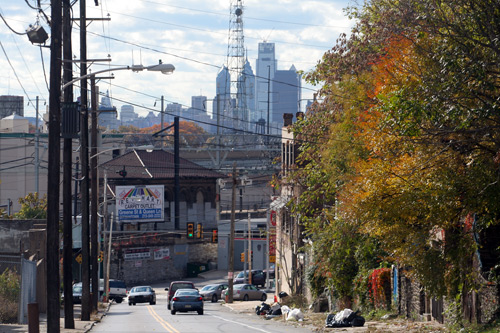
–Nathaniel Popkin
nathaniel.popkin@gmail.com
For more on The Possible City, please see HERE.
For Nathaniel Popkin archives, please see HERE, or visit his web site HERE.
|
   
3 December 07: Rise and shine, Comcast Center
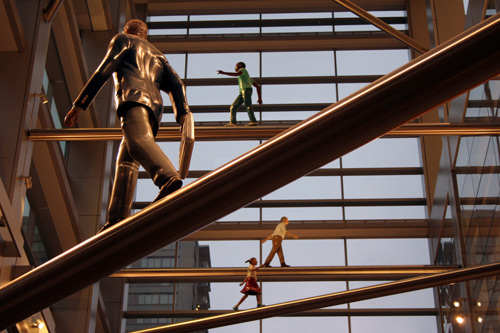
There was little pomp and little circumstance (though apparently there was a Mummers band), but this morning Philadelphia's largest corporation and the largest
television cable provider in the world quietly -- nay, softly -- opened the doors of its new headquarters at 17th & JFK.
Comcast Center's soft opening this morning saw its chief executives on hand to welcome the first 200+ employees into the building while work continues on the upper
floors and concourse. I arrived around 6:30 via the El, following the signs that have been mounted in Suburban Station's concourse for a year and entering via the grand staircase.
On just its first day, still incomplete, Comcast
Center already has one of the best lobbies of any building in the city: the connection to the station, the space overhead filled with sculptures that make you look
their direction, the natural light from all the glass, the general newness of it all. Off the top of my head, the Curtis Center is the only other public
lobby that gives it a run for its money.
I was on hand long enough to say hi to Comcast's David Cohen, Brian Roberts and Ralph Roberts (pictured below) and snap a handful of photos (32 total) on this
opening day. They're all on one page, about 5.5M in size, so let 'er load and have a look
HERE.
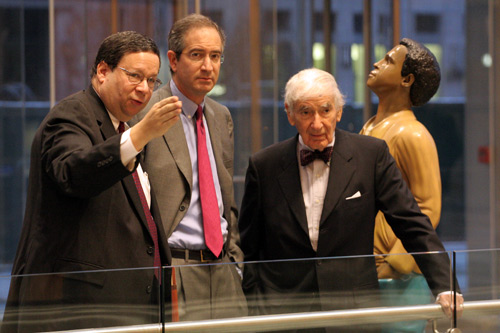
–B Love
|
3 December 07: Higher than usual at 40th & Pine
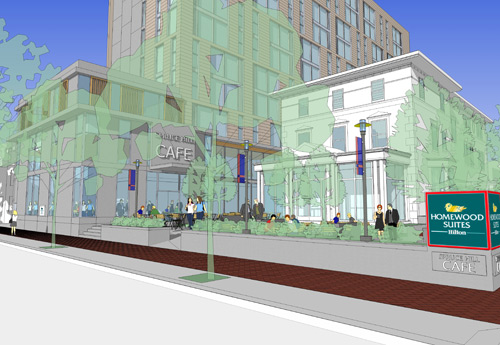
I probably prepared for three weeks back in 1994 or 95 for the arrival of Tom Lussenhop. I was the staff planner manning an "Office of Community Planning," a
project of Ira Harkavy's Center for Community Partnerships at Penn. Tom was the real deal, hired by Penn Executive Vice President John Fry to implement some of
the strategies we'd been crafting -- a Penn-assisted public school, a housing program, the upgrade of 40th Street, the University City District.
Tom was coming to Philadelphia by way of Newark, where he was instrumental in building the Regional Performing Arts Center; he was young, but slightly older than
I, caffeinated, and willing to work like the devil to implement strategies that would be a national model. He simply overpowered the reigning bureaucracy by force
of charm and a keen analytic sense. A midwesterner, Tom fell a little in love with Philadelphia and years later I would see him around town on his bicycle or
walking through Rittenhouse Square. He has proven his mettle in Philadelphia, building the first new construction residential building in University City (condos
at 43rd and Osage) since the 1970s and now, all things circling back to their origins, he's well on the way to building a hotel at 40th and Pine.
I like this project, a Hilton Homewood Suite designed by Sam Olshin of Atkin Olshin Schade with 120 units and a separate restaurant/bar, for a handful of important
reasons. First, as Tom mentioned to me, the
hotel is perfect transit-oriented development; its prime amenity is the 40th Street trolley portal a block away, where Septa runs 800-1,000 trolleys a day, a 12
minute ride to City Hall. It anchors that end of a critical retail district by adding density; it renovates a historic Italianate mansion, which has been in
disrepair for decades, while adding interesting height -- a slender 11 story tower. Importantly, it helps diversify the area's uses; nothing is more important for
the health of a city neighborhood. Finally, it's a hotel in just the place there ought to be one where there never is in Philadelphia; perhaps the small amount of
early opposition to this is a knee-jerk reaction against hotels in neighborhoods. (Ed. note: Unrelatedly, Bart Blatstein's Tower Investments has a boutique
hotel eyed for the dilapidated corner of 2nd & Poplar, catty-corner to Standard Tap.)
Well, the most interesting cities have a diverse lot of hotels in all different kind of places.
–Nathaniel Popkin
|
 
 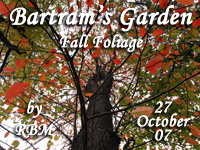
3 December 07: Evergreen construction
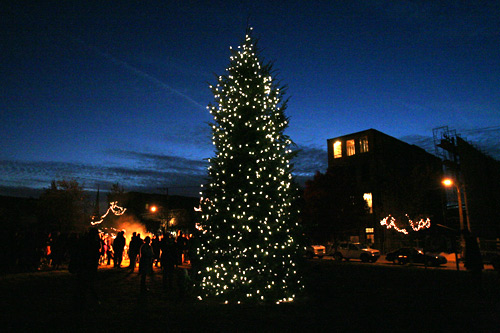
Tis the season, friends, for . . . ecological rethinking of Christmas trees??? While Love Park and Rittenhouse Square propped up your standard trees and City Hall
rolled out LEDs for this year, the newly formed Northern Liberties Business Owners Association took xmas trees to a whole other level.
The 40' tree pictured above was harvested from the nether regions of North Central PA, sent on a flatbed to Philly, and installed in the middle of the park on 3rd,
between Poplar and Wildey. The lights on the tree are powered by a single solar panel, the trunk of the tree will be cut and used to make benches for the park, and
the rest of the tree will be chopped and used as mulch for the dog portion of Liberty Lands.
–B Love
|
30 November 07: Into the Center
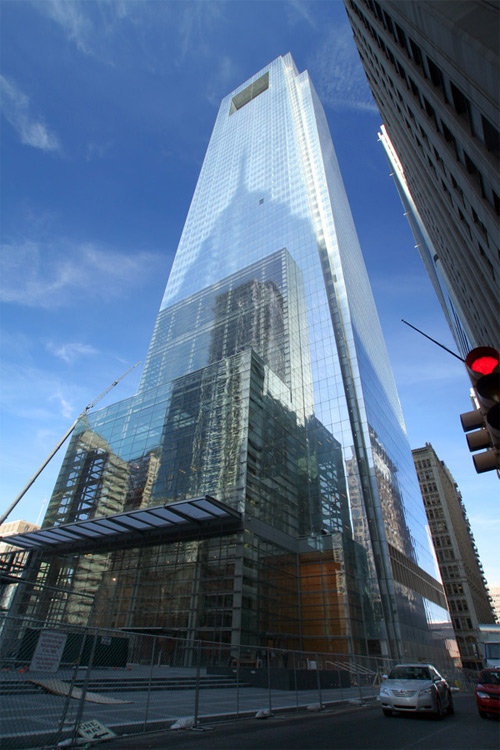
Through these doors enter the most important people in the world: your cable providers! Monday morning, over 200 Comcast employees will move into their shiny new
digs at Comcast Center, officially (but softly) opening Philadelphia's latest office tower.
But wait, there's more: you can celebrate, too! The fence surrounding the plaza is scheduled to be removed this weekend and it will be open to the public for the
first time on Monday. As well, the causeway from Suburban Station into the winter garden will be open for the first time on Monday, so make like a commuter and
walk in from underground, up the grand staircase and into the ten-story atrium. You won't be able to miss Jonathan Borofsky's Humanity in Motion above you.
I've been assured by the head of security that photography will be permitted in public spaces.
While business as usual gets going in the new offices on the lower floors, work will continue on the upper floors and crown of the tower. Over the past week, the
crown has become less transparent as the walls of the tuned liquid column damper are built. When Comcast Center is complete, the crown will be fully illuminated
and connected to the corners which will be lit all the way to the ground (and which was previewed in September).
You may be happy to know that our construction photos section has been updated.
Hope you have yourself a nice weekend as we head into December . . . and with December comes the pressures of buying gifts. Well don't you know your friends at
Philly Skyline are here to help: we've got calendars for 2008 that will look great on your boss's cubicle wall, or in your kid's dorm room, or in
your loved one's office. The calendar is at the printer as we speak, so we'll have them in plenty of time for Christmas, Hanukkah, Kwanzaa, Festivus, the Mummers
Parade, or whatever holiday you do or do not celebrate this time of year. We'll have all the details on how you can purchase them (via pre-order online and the
physical places that will carry them) next week.
Till then? Carpe diem, y'all!
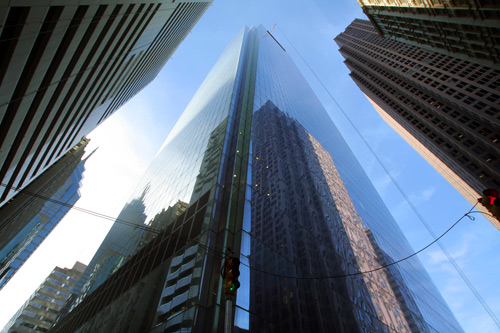
–B Love
|
|














































